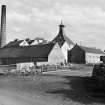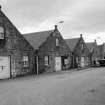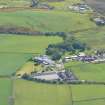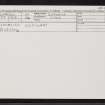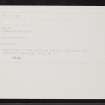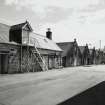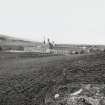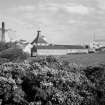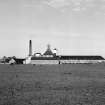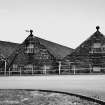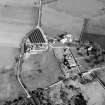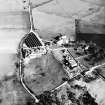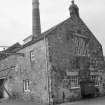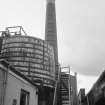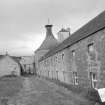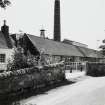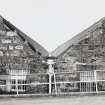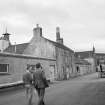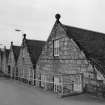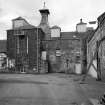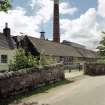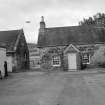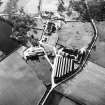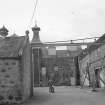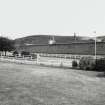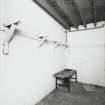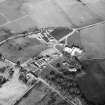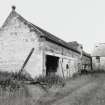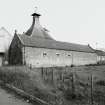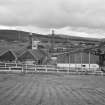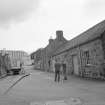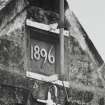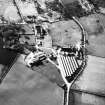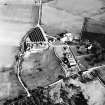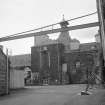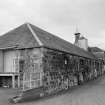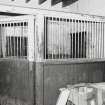Brora, Clynelish Road, Old Clynelish Distillery
Distillery (19th Century) (1896)
Site Name Brora, Clynelish Road, Old Clynelish Distillery
Classification Distillery (19th Century) (1896)
Alternative Name(s) Brora And Clynelish Distilleries; Brora Distillery
Canmore ID 6487
Site Number NC80NE 40
NGR NC 89707 05498
Datum OSGB36 - NGR
Permalink http://canmore.org.uk/site/6487
- Council Highland
- Parish Clyne
- Former Region Highland
- Former District Sutherland
- Former County Sutherland
NC80NE 40 89707 05498
See also NC80NE 44 (New Clynelish Distillery).
(Location cited as NC 897 054). Clynelish Distillery, founded 1819 by the Sutherland Estate, and enlarged in 1896 by Ainslie and Co. The chimney, fine malt kiln and malting floors probably date from the rebuilding, but much of the original structure apparently survives within the complex.
J R Hume 1977.
Originally founded as Clynelish Distillery in 1819. In 1967-8 a new Distillery opened on an adjacent site (NC80NE 44) and was given the name Clynelish Distillery; at this point NC80NE 40 was closed and reopened in 1975 as Brora Distillery. The aerial photograph B49564 shows NC80NE 40 to the left and NC80NE 44 to the right and can be used as a guide towards identifaction.
Information from RCAHMS (SDC), 14 September 2000 and 10 September 2002.
Publication Account (1995)
The old distillery was built in 1819 by the Sutherland estate with the intention of affording their smaller tenants 'a steady and ready market for their grain without their being obliged to dispose of it to the illegal distillers'. A plan of the distillery in 1819 shows that part of the buildings were given over to a piggery, for the pigs ate the spent grain discarded after mashing. A farm was attached to the distillery and given a large allocation of unimproved land 'in consequence of the command of manure which the distillery will afford the tenant'. Finally coal from the new coal mine the Sutherlands had opened at Brora was used in the furnaces. The old distillery was completely rebuilt in 1896-7 to meet increased demand, but a stone with the Sutherland/Stafford arms is preserved In the gable end of the still house.
In this range of buildings, now disused, much of the old equipment remains. First comes the long open plan malt-room where barley after being soaked in water was spread out on the stone floor and allowed to germinate. Iron pillars support a wooden-floored gra in loft above. Part of this block is the cask-room, now the only part of the old works shown to visitors. Next comes an elevator which took grain to the kiln, where kiln-drying stopped germination at the critical point. The kiln has a peat-fired furnace at the bottom, and the grain was spread on a perforated iron grid at first loor level. The kiln has the typical pagoda roof and ventilator above. Beside this is the mill-room where the malted grain was ground to a coarse meal; a water-wheel originally turned the grinding rolls and also the grain-stirrer in the mash tun where the sugars were removed, leaving the husks (which make animal feed, hence the pigs). After mashing, the sugar solution was then fermented in wooden vats ca lled 'wash- backs'. The coal-fired boiler-house with its tall chimney supplied heat to work the two great copper pot sti lls in the still room, where the wash was converted into highstrength spirit. From the st ills the spirit had to be cooled, and in the old distillery it passed down immensely long coils of tubing, gradually decreasing in size, inside huge round wooden tanks called 'worm tubs', which stand at the back of the still house. Opposite all this is the line of bonded warehouses where the whisky, under the eye of an Excise Officer, still spends at least five years in casks before it is sold. The warehouses are openplan inside, the bays separated by rows of iron columns. One block is dated 1896 and the other block is earlier.
The new oil- fired distillery built in 1967-8 has taken over the name Clynelish. It uses malted barley already processed in a plant at the Muir of Ord, and so starts with the fermenting stage. The processes are traditional though some of the equipment, such as the condensers, are new. Inside the distillery there is a row of gleaming copper pot stills of the old pattern (each distillery has its own shape). Some of the spirit from this distillery is bottled as Clynelish Single Malt, and some goes to be blended.
Information from ‘Exploring Scotland’s Heritage: The Highlands’, (1995).
Standing Building Recording (10 July 2018 - 15 July 2018)
A Level 1 photographic survey has been completed of the Cynelish Old Distillery works at Brora, in advance of renovation and upgrading work by owners Diageo.
Information from OASIS ID: highland4-389365 (A Young) 2018






















































